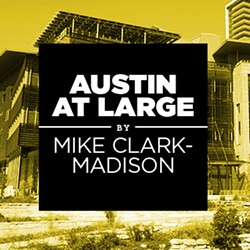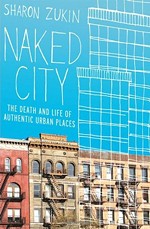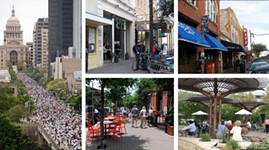Austin @ Large: To Preserve and Thrive
Alvarez and Thomas' Eastside plan needs fine-tuning, but it's about time
By Mike Clark-Madison, Fri., Oct. 15, 2004

Within the CP&R Zone – roughly between I-35, U.S. 183, Manor Road, and Riverside Drive – certain development projects would be eligible for property tax rebates, based on how many jobs they create or how many commercial square feet they add to the tax base. That's the revitalization part. But those same developers would also be required to create affordable housing units – at a lower income threshold than is used citywide – and to contribute to a new Homeowners Assistance Fund that would subsidize (through utility bill vouchers) the poorest residents of East Austin, in amounts designed to offset those residents' escalating property tax bills. That's the preservation – i.e., anti-gentrification – part.
I'm biased on this subject, because I live in East Austin and am involved in its neighborhood affairs. But the problems the CP&R plan aims to help solve are, in my estimation, the most significant and difficult challenges facing Austin over the next decade – more so than transportation, or environmental protection, or public safety, or the city's fiscal health, or even "job creation" and "economic development" in the abstract.
The need for revitalization, without gentrification, doesn't exist just on the Eastside, though that is where the challenges are now the most visible and acute. If the community can't successfully create well-planned and well-managed infill growth in East Austin, without sacrificing affordability or (further) harming social equity, it's unlikely to succeed elsewhere. Indeed, Austin may have already lost the chance elsewhere to achieve these essential goals. So even if Alvarez and Thomas were offering up total hogwash, they're still doing the work of the angels and deserve credit for it.
Incentives for Whom?
But is it hogwash? It's impossible to say without acknowledging that the tension and ambivalence embedded in the CP&R plan – revitalization without gentrification, or perhaps more simply, growth without change – is common in Austin but is endemic on the Eastside. We can fairly claim that an effort like the CP&R plan, if adopted, would be the boldest step Austin has yet taken to get the wobble out of Kirk Watson's famed "three-legged stool" (prosperity, sustainability, and equity). But it's not the first time an Eastside-wide enterprise zone has been contemplated, and it's hardly the first concerted effort to reinvent or reinvigorate East Austin in a more-or-less sensitive manner. But still the Eastside lags, as Alvarez and Thomas noted with a raft of statistics when making their pitch. Why?
The short answer is that you can't change the Eastside without changing the west side, but the rest of Austin, let alone Central Texas, is comfortable enough with our region's cultural and economic segregation to not want to see it abolished at the "expense" of the whiter and wealthier. Thus there must be a poor side of town where the people of color live, and if it weren't East Austin it would be somewhere else. The most effective way to counter gentrification, throughout Austin, would be to create affordable infill housing and living-wage jobs, in ample and equivalent qualities, both east and west of I-35, and eliminate at least the economic need or rationale for a ghetto.
But as we wait for the moon to fall from the sky, we have little choice but to minister to East Austin in a vacuum, which has long required one or another kind of public incentive to make the Eastside more "attractive" or "competitive," which has long meant, at least implicitly, "more like the west side," which is what we typically mean by "gentrification" and which rightly troubles the Eastside. For Anglos like me, and for citywide leaders spending public money like Alvarez and Thomas, the misgivings tend to, or have to, skew toward class and away from race; gentrification is an economic phenomenon that's just as corrosive in Hyde Park as in Govalle.
But to African-Americans and Latinos outside the public sector, the two are more often inextricable; gentrification means racial change. As I read the CP&R plan's scenarios, if The Austin Chronicle relocated to East Austin, we could easily qualify for CP&R tax incentives. I doubt we would seek them – independence of the press and all that – so perhaps that's a bad example. But insert the local funky Birk-Belt institution of your choice. I think I can write Sterling Lands' or Susana Almanza's talking points right now. If for no other reason than to tamp down the political fires, it would seem imperative that, if the CP&R plan goes through, the city needs to aggressively recruit black and brown businesses (defined however you want) to be the first beneficiaries.
Making It Work
There are other rough spots in the CP&R plan that I'm sure Alvarez and Thomas recognize as well as anyone, so I don't feel too uncharitable raising them. A broad blanket zone for incentives may not make the most possible sense; I'm not sure my own neighborhood, close to I-35 and already within the orbit of the East 11th and 12th Street renewal plan, needs further "incenting," as our president would say. Likewise for the north side of Riverside Drive, at least west of Pleasant Valley. It might make more sense to offer more generous incentives – ones that could be tapped even by the smallest-scale developments – in more localized target areas within the overall CP&R zone, or even beyond it.
And while the Homeowners Assistance Fund is a valuable concept, as conceived in the test tube it might simply not offer enough assistance to make a difference, in a community where Austin's share of the overlapping tax bill is only 18%. I don't think a CP&R-like strategy should be dependent on buy-in from other taxing jurisdictions, or from the state, but it's incumbent on the city to at least pursue all its options.
And, of course, you may have noticed that I'm not normally a fan of the whole tax-rebate strategy to begin with. I'm less skeptical about CP&R than are some of my cohorts on this front (like, say, the Statesman's Bill "Lasso" Bishop), but I agree that there are some missing planks on this bridge – investments in infrastructure and public safety, in workforce development, in options for youth and families on the Eastside – that need to be installed so East Austinites can actually cross over to the opportunities these new projects offer. The city already knows this and is making those investments, as are other local taxing entities, but we need to be realistic about how much tax revenue we can give back to developers, as opposed to earmarking for those investments in equity.
But having said all that, I'm a damn sight more interested in seeing a CP&R plan succeed than in seeing the City Council throw more tax candy at Northwest Austin shopping malls. There's a plenty long way to go here, but the road is the right one. ![]()
Got something to say on the subject? Send a letter to the editor.










